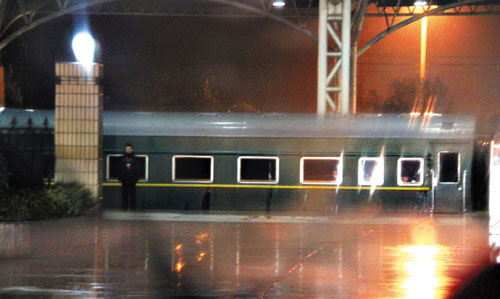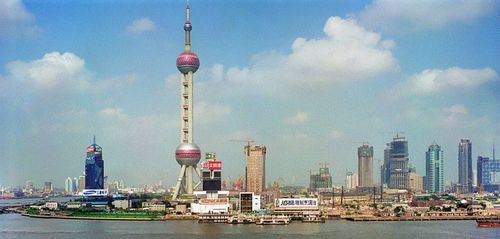“Chat-to-China” Choo Choo: Kim Rides the Rails Again

So let’s review the ones we know for a fact. Some of us are old enough to remember the first time, way back in June of 1983. In the cyclical pattern now repeating in Pyongyang, then it was the youngish Kim Jong Il (42 or maybe 43, so not quite so callow a youth as Kim Jong Un now) who was the dauphin in waiting. Freshly unveiled to the world two-and-a-half years before—which suggests it may be a bit soon for Kim Jong Un, still wet behind the ears, to make the solo trip to China that the rumor mill in Seoul, rarely to be trusted, first and wrongly reported this time—the Dear Leader, at that point, needed to be seen to be accepted by China; China’s own move away from one-man dictatorship suggested that to endorse something so grotesquely anti-communist as a quasi-monarchical succession was no foregone conclusion.
But endorse it they did, and how. Swallowing any distaste it may have felt, China rolled out the red carpet for Kim, time and time again, on his ten-day trip. This first announced visit set a pattern that would endure, in two respects: it was officially unofficial and he came by train.
I, for one, shall never forget this. A few months later in Japan, the comrades at Chongryun—the pro-North ethnic Koreans in Japan—insisted on showing me the film of this visit: in full, at length, almost in real time (I think it ran three hours). Someone, possibly Brad Martin, wrote wittily at the time about this experience. The train leaves the station, slowly. The train goes ‘round a scenic bend. And another. And yet another. The train pulls into a station. Kim Jong Il gets off. He is greeted: kids with flowers, parades, dignitaries. He is shown things: factories, monuments. He gets back on the train. It pulls out of the station. More going ‘round the bend. By now the viewer is going ‘round the bend too. (I wonder if this is on YouTube?)
One scene stands out: Kim’s host is Deng Xiaoping, no less. They are visiting a monument and climbing a lot of steps. The portly guest is making heavy weather of this. Deng, almost twice his age but a nimble veteran of the Long March, gallantly puts his arm around Kim to give him a bit of much-needed help. A touching moment, and a telling one.
This could stand as a metaphor for the whole trip, maybe even the whole relationship. Then as now, China would like to guide North Korea onto the straight and narrow: the steep ascent towards a more sensible and self-sustaining economy, even if politics remains a no-go zone.
So this first time, already, Kim Jong Il’s itinerary included Shenzhen. Then, by no means yet the bustling city it has since become, China’s first special economic zone was already a clear harbinger of the new pragmatism that Deng was unmistakably and irreversibly introducing.
Was Kim impressed? Evidently not. Despite his warm public welcome (perhaps cooler in private?) 17 long years would pass before he was to set foot in China again. In all that time, North Korea showed no sign of emulating Deng’s economic policy. Political ties became strained too, above all by Beijing’s growing courtship of the other Korea: attending the 1988 Seoul Olympics and forging full diplomatic relations in 1992 (two years after Moscow first took the plunge, though more clumsily and garnering worse flak.) For all the talk of cross-recognition in those years, in the end, it was Seoul that got recognition while Pyongyang just got cross.
A new century dawned before Kim Jong Il’s train rolled across the Yalu again, in late May (29-31) 2000. This sudden brief three-day visit, announced only when it was over, may have been meant to mend fences generally, but its timing suggested a very specific motive: to gain Jiang Zemin’s blessing for—or at least give him personal warning of—the first ever inter-Korean summit meeting, held just a fortnight later. By then Beijing had replaced Moscow as Pyongyang’s reluctant but indispensable cash cow, so China’s imprimatur was essential.
Kim’s third visit followed in quick succession. No 17-year hiatus this time, just a mere seven months. A slightly longer stay, five days (January 15-20, 2001) gave Kim’s armored train time to trundle not only to Beijing—his sole stop in May 2000—but on to Shanghai, where his itinerary included the stock exchange. However, any hopes this visit may have raised at the time, were soon dashed. The Shanghai skyline mightily impressed Kim Jong Il—so much so that the order went out: Train more architects! (Germany gave some scholarships, but France made them pay.)[2]
For a man who seems to be no fool, this is a gross category error. The skyline was secondary; the point was the system that built it. Did Kim really not get that, or was he dissembling?
Either way, three years passed before he returned to China. His fourth visit, in April 2004, was again rather short and to Beijing only, hence primarily political. By contrast, his fifth trip less than two years later, in January 2006, lasted over a week and was largely economic in focus. Kim returned to Shenzhen, 22 years after his first visit; he also visited Guangzhou, Wuhan, and Zhuhai. Thanking his host Hu Jintao at the farewell banquet, he spoke of being “deeply impressed by [China’s] shining achievements… in the high-tech field” and “special economic zones, making a great contribution to the socialist modernization drive.” Nor did he forget: “Still fresh in my memory is my visit to Shanghai five years ago that has changed beyond recognition.”[3] But he drew no deeper lessons, or if he did, he was not about to say so.
Curiously, and with little publicity—none at all in the DPRK media—two months later in late March a 30-person delegation led by Kim’s brother-in-law, Jang Song Thaek, retraced his route exactly.[4] Jang himself had only recently bounced back after two years in the doghouse for unclear reasons; he vanished in June 2003, reappearing in public in January 2006. This exercise once again raised hopes that North Korea might at last be ready (if I may borrow a rolling phrase from the Anglican Book of Common Prayer) to “read, mark, learn, and inwardly digest” the lessons of Chinese economic policy, rather than misreading or ignoring them. But as ever, such hopes were dashed. No discernible outbreak of pragmatism followed in Pyongyang.
Four years passed without Kim Jong Il visiting China again. Yet now, with unprecedented intensity, since the May 2010 visit that went badly—it seems he stormed home a day early—Kim has made the trip three times in barely a year. A new twist on the two latest occasions is that he has taken more easterly routes, spending time in Northeast China. Last August, in a rare honor, President Hu Jintao went to Changchun and feasted him there. Kim toured not only factories, but also places where his father had stayed in China, and for the first time, admitted that he had lived there too. He didn’t give details, but as a child he was evacuated to Jilin in late 1950 when most of the DPRK was briefly overrun during the Korean War, before Chinese intervention turned the tide and saved Kim Il Sung’s bacon.
This time—his eighth visit—Kim Jong Il’s itinerary thus far is peculiar indeed. Crossing the Tumen River, for a change, in the DPRK’s far northeast—almost as if headed for Siberia—he passed briefly through Changchun, where he toured a car factory, before heading south, not for Beijing, as had been widely assumed, but all the way down to Yangzhou, northwest of Shanghai.[5] Home to Hu Jintao and his predecessor Jiang Zemin, Yangzhou is where Jiang and Kim Il Sung held talks in 1991. Pyongyang has a penchant for decennial anniversaries. It has also been ten years since Kim Jong Il’s “ooh-aah” tour of Shanghai and its space-age skyline.
Unusually, Kim’s presence has been officially confirmed while he is still in China. His trip coincides with one of the now regular trilateral summits between the three serious countries in Northeast Asia, held this time in Japan. Maybe Wen Jiabao got fed up with all the pretence and inconvenience: an armored train and convoys of limos are hard to hide and ludicrous to deny. In speaking with ROK President Lee Myung Bak, Premier Wen confirmed Kim’s visit. Its aim? To give the DPRK “a chance to understand China’s development, and use the understanding for its own development.” That tone won’t play well in Pyongyang
Rewind 28 years, and Deng Xiaoping could have said the exact same thing. Perhaps he did. You do wonder just how often this obdurate horse has to be led to water. Will he ever drink? Maybe this time. Kim is out of cash, out of food—not him personally, obviously—and out of options. Lee Myung Bak has ditched the ROK’s former Sunshine Policy, so China is all he’s got. Beijing will do a certain amount in any case, but for serious investment in infrastructure and mines it will demand seriousness from its counterparty: Get real, get rules, get markets, and get your act together. That message may be no more palatable to Kim Jong Il in 2011 than it was in 1983. But this time, as Margaret Thatcher used to say, there is no alternative.
[1] Se Young Lee, “China Confirms Visit by North Korea’s Kim,” Wall Street Journal Asia, May 22, 2011,
http://online.wsj.com/article/SB10001424052702304520804576339052444645420.html?mod=googlenews_wsj.
[2] Or so I was reliably informed at the Quai d’Orsay, a year or two afterwards. See also David Rennie, “North Koreans are starving, but all Kim wants is a skyline to match Shanghai’s,” The Telegraph, August 8, 2001, http://www.telegraph.co.uk/news/worldnews/asia/northkorea/1336762/North-Koreans-are-starving-but-all-Kim-wants-is-a-skyline-to-match-Shanghais.html.
[3] “Speech of by [sic] Kim Jong Il at Banquet,” Korean Central News Agency (KCNA), January 18, 2006,
http://www.kcna.co.jp/item/2006/200601/news01/19.htm#2.
[4] Scott Snyder, “China-Korea Relations: Kim Jong-il Pays Tribute to Beijing—In His Own Way,” Comparative Connections 8:1, April 2006, http://csis.org/files/media/csis/pubs/0601qchina_korea.pdf.
[5] See map and comment at http://nkleadershipwatch.wordpress.com/2011/05/22/kim-jong-il-in-yangzhou/.

